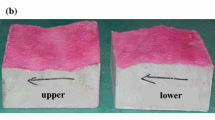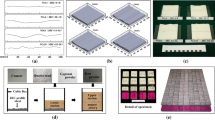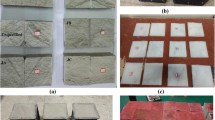Abstract
This study aims to elucidate the mechanism of velocity-dependent peak shear strength (PSS) for rock joints by examining the three-dimensional distribution characteristics of actual contact joint surface. Shear tests are conducted on saw-cut joints (SCJs) and natural rough rock joints under varying shear velocities (v) but a constant normal stress. The test results reveal that the PSS of SCJs decreases with increasing shear velocity, whereas the PSS of rough joints increases with v. Through analysis of the impact of v on the contact area, a PSS model is developed. The model demonstrates that for SCJs, the contact area decreases with increasing v, resulting in a reduction in the basic friction angle. Conversely, for rough joints, the contact area decreases with increasing v. However, it is observed that, considering the distribution characteristics of the apparent dip angle of asperities on the joint surface, the average roughness of joint surface increases as the contact area decreases. It is the increase in roughness that subsequently leads to an increase in the PSS of rock joints. The new model incorporates the influence of v on both the basic friction angle and peak dilation angle, and the interplay between these factors determines the PSS of rock joints.
Highlights
-
Shear tests of rock joints are carried out under a constant normal stress with different shear velocities.
-
A peak shear strength model considering shear velocity is obtained by analyzing the distribution of joint surface and shear velocity on the contact area.
-
The influence of shear velocity on basic friction angle and dilation angle is taken into account in the new model.
-
The competition between basic friction angle and dilation angle determines the increase or decrease of the peak shear strength of rock joints.












Similar content being viewed by others
Data Availability
All data, models, or codes generated or used during the study are available from the corresponding author by request.
References
Atapour H, Moosavi M (2014) The influence of shearing velocity on shear behavior of artificial joints. Rock Mech Rock Eng 47(5):1745–1761
Ban L, Du W, Qi C (2020a) A peak dilation angle model considering the real contact area for rock joints. Rock Mech Rock Eng 53:4909–4923
Ban L, Qi C, Chen H et al (2020b) A new criterion for peak shear strength of rock joints with a 3D roughness parameter. Rock Mech Rock Eng 53:1755–1775
Barton N, Choubey V (1977) The shear strength of rock joints in theory and practice. Rock Mech 10(1–2):1–54
Chen X, Zeng Y, Sun H et al (2019) A new model of the initial dilation angle of rock joints based on Grasselli’s morphological parameters. China J Rock Mech Eng 38:133–152
Crawford AM, Curran JH (1981) The influence of shear velocity on the frictional resistance of rock discontinuities. Int J Rock Mech Min Sci Geomech Abstr 18(6):505–515
Dieterich JH (1972) Time-dependent friction in rocks. J Geophys Res 77(20):3690–3697
Dieterich JH (1978) Time-dependent friction and the mechanics of stick-slip. Pure Appl Geophys 116(4–5):790–806
Ge Y, Chen K, Liu G et al (2022) A low-cost approach for the estimation of rock joint roughness using photogrammetry. Eng Geol 305:106726
Grasselli G, Wirth J, Egger P (2002) Quantitative three-dimensional description of a rough surface and parameter evolution with shearing. Int J Rock Mech Min Sci 39(6):789–800
Hadi F-A (2021) Data-driven estimation of joint roughness coefficient. J Rock Mech Geotech Eng 13(6):1428–1437
Homand F, Belem T, Souley M (2010) Friction and degradation of rock joint surfaces under shear loads. Int J Numer Anal Meth Geomech 25(10):973–999
Jaeger JC (1971) Friction of rocks and stability of rock slopes. Geotechnique 21(2):97–134
Jafari MK, Hosseini A et al (2003) Evaluation of shear strength of rock joints subjected to cyclic loading. Soil Dyn Earthq Eng 23(7):619–630
Jiang Q, Yang B, Liu C et al (2020) New method for characterizing the shear damage of natural rock joint based on 3D engraving and 3D scanning. Int J Geomech 20(2):06019022
Johansson F, Stille H (2014) A conceptual model for the peak shear strength of fresh and unweathered rock joints. Int J Rock Mech Min Sci 69:31–38
Kulatilake P, Shou G, Huang TM et al (1995) New peak shear strength criteria for an isotropic rock joints. Int J Rock Mech Min Sci Geomech Abstr 32(7):673–697
Li H, Feng H, Liu B (2006) Study on strength behaviors of rock joints under different shearing deformation velocities. Chin J Rock Mech Eng 25(12):2435–2440
Liu X, Huang J, Zhao J et al (2022) Laboratory-scale investigation of response characteristics of liquid-filled rock joints with different joint inclinations under dynamic loading. J Rock Mech Geotech Eng 14(2):396–406
Luo G, Zhang H, Ma G et al (2020) Study on sliding tribological characteristics of the sliding plane of a high-speed rockslide: taking the Wangshan-Zhuakousi rockslide as instance. Rock Soil Mech 41(07):2441–2452 (in Chinese)
Meng F, Wong Y, Zhou H et al (2019) Shear rate effects on the post-peak shear behavior and acoustic emission characteristics of artificially split granite joints. Rock Mech Rock Eng 52(7):2155–2174
Mirzaghorbanali A, Nemcik J, Aziz N (2014) Effects of shear rate on cyclic loading shear behaviour of rock joints under constant normal stiffness conditions. Rock Mech Rock Eng 47(5):1931–1938
Patton FD (1966) Multiple modes of shear failure in rock. In: Proc 1st International Congress of Rock Mechanics. Lisbon, Portugal, pp 509–513
Sun FT, Jiang QR, She CX (2012) Research on three-dimensional roughness characteristics of tensile granite joint. Appl Mech Mater 204–208:514–519
Tang Z, Wong L (2016a) New criterion for evaluating the peak shear strength of rock joints under different contact states. Rock Mech Rock Eng 49(4):1191–1199
Tang Z, Wong L (2016b) Influences of normal loading rate and shear velocity on the shear behavior of artificial rock joints. Rock Mech Rock Eng 49(6):2165–2172
Tang H, Ge Y, Wang L et al (2012) Study on estimation method of rock mass discontinuity shear strength based on three-dimensional laser scanning and image technique. J Earth Sci 23(6):908–913
Tatone BS (2009) Quantitative characterization of natural rock discontinuity roughness in situ and in the laboratory. Dissertation, University of Toronto
Tian Y, Liu Q, Liu D et al (2018) Updates to Grasselli’s peak shear strength model. Rock Mech Rock Eng 51(7):2115–2133
Tse R, Cruden DM (1979) Estimating joint roughness coefficients. Int J Rock Mech Min Sci Geomech Abstr 16(5):303–307
Wei X, Shen Y, Li X et al (2022) Influence of freeze–thaw cycles and shear rate on sandstone-concrete interfacial bond strength: experiment and degradation model. Constr Build Mater 327:126986
Xia C, Tang ZC, Xiao WM et al (2014) New peak shear strength criterion of rock joints based on quantified surface description. Rock Mech Rock Eng 47(2):387–400
Xing A, Yuan X, Xu Q et al (2016) Characteristics and numerical runout modelling of a catastrophic rock avalanche triggered by the Wenchuan earthquake in the Wenjia valley, Mianzhu, Sichuan, China. Landslides 14(1):1–16
Yang J, Rong G, Hou D et al (2016) Experimental study on peak shear strength criterion for rock joints. Rock Mech Rock Eng 49:821–835
Yu J, Liu G, Cai Y et al (2020) Time-dependent deformation mechanism for swelling soft-rock tunnels in coal mines and its mathematical deduction. Int J Geomech 20(3):4019186
Yuan W, Li J (2021) Study on the effects and its mechanism of shear rate on friction of planar joints. Chin J Rock Mech Eng 40(S2):3241–3252 (in Chinese)
Zheng B, Qi S (2016) A new index to describe joint roughness coefficient (JRC) under cyclic shear. Eng Geol 212:72–85
Zheng B, Qi S, Zhan Z et al (2015) Effect of shear rate on the strength characteristics of rock joints. J Earth Sci Environ 37(05):101–110
Zhu Y, Wang G, Li A et al (2022) Effects of joint roughness, shear rate, and normal stress on shear behavior and acoustic emission characteristics in two parallel coplanar intermittently jointed rock: an experimental study. Rock Mech Rock Eng 56(2):1289–1303
Acknowledgements
This study is supported by the National Natural Science Foundation of China (Nos. 52208328 and 52104090) and the Special Projects of Science and Technology Innovation Entrepreneurship Funds by the China Coal Technology Engineering Group (No. 2022-MS003).
Funding
This work was supported by the National Natural Science Foundation of China with Grant numbers (52208328 and 52104090), and the Special Projects of Science and Technology Innovation Entrepreneurship Funds by China Coal Technology Engineering Group with Grant number (2022-MS003).
Author information
Authors and Affiliations
Corresponding authors
Ethics declarations
Conflict of interest
The authors declare that they have no competing financial interests or personal relationships that could have appeared to influence the work reported in this paper.
Additional information
Publisher's Note
Springer Nature remains neutral with regard to jurisdictional claims in published maps and institutional affiliations.
Rights and permissions
Springer Nature or its licensor (e.g. a society or other partner) holds exclusive rights to this article under a publishing agreement with the author(s) or other rightsholder(s); author self-archiving of the accepted manuscript version of this article is solely governed by the terms of such publishing agreement and applicable law.
About this article
Cite this article
Ban, L., Du, W., Zheng, D. et al. Velocity-Dependent Effect on the Peak Shear Strength of Rock Joints Considering the Distribution Characteristics of Contact Joint Surface. Rock Mech Rock Eng 57, 2523–2537 (2024). https://doi.org/10.1007/s00603-023-03690-9
Received:
Accepted:
Published:
Issue Date:
DOI: https://doi.org/10.1007/s00603-023-03690-9




